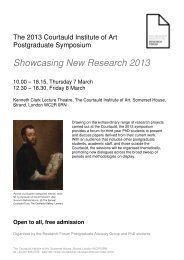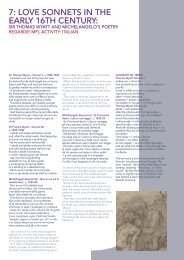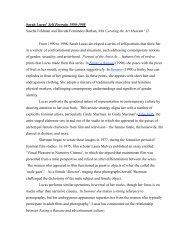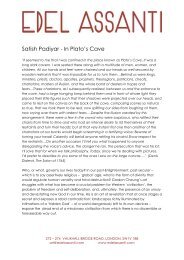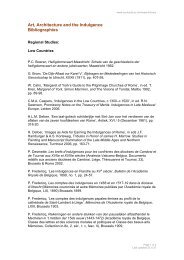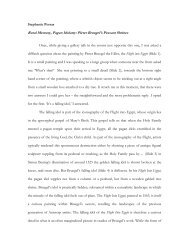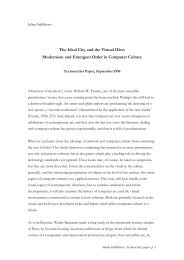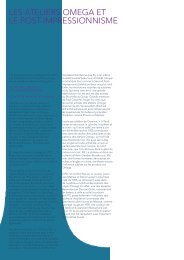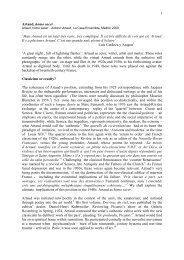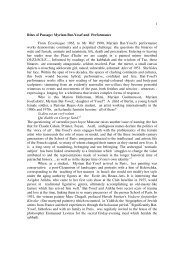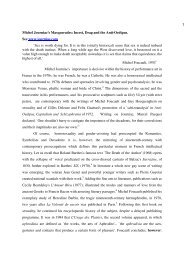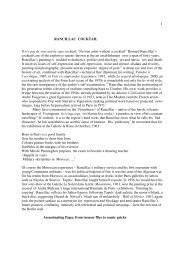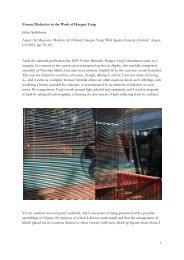Iluna gordelekuan/ Oscuridad en el refugio - The Courtauld Institute ...
Iluna gordelekuan/ Oscuridad en el refugio - The Courtauld Institute ...
Iluna gordelekuan/ Oscuridad en el refugio - The Courtauld Institute ...
You also want an ePaper? Increase the reach of your titles
YUMPU automatically turns print PDFs into web optimized ePapers that Google loves.
described them as ‘a vague s<strong>en</strong>se of insecurity, a cosmic anguish (Angst, as the Exist<strong>en</strong>tialists<br />
call it), fe<strong>el</strong>ings and intuitions that demand expression in abstract or unnaturalistic forms.’<br />
<strong>The</strong>re is nothing inhuman about these forms, rather they are ‘inevitable modes’ in which<br />
certain phases of human experi<strong>en</strong>ce are expressed. 37<br />
To apply this to Moore th<strong>en</strong>, his pieces<br />
might seem inhuman, but this is an illusion caused by the changing historical mom<strong>en</strong>t: they<br />
are in fact as universal as any other kind of true art.<br />
Critics oft<strong>en</strong> wrote of Moore’s work in these universal terms, as a substantiation of the<br />
age, the struggles and suffering of mankind. 38<br />
This was just the kind of reading that was<br />
criticized by John Berger for being too g<strong>en</strong>eral: ‘Moore’s great popularity, can, I think, like<br />
Sutherland’s, be larg<strong>el</strong>y explained by the pres<strong>en</strong>t s<strong>en</strong>tim<strong>en</strong>tal, highbrow fashion for projecting<br />
crises of consci<strong>en</strong>ce and introspection on to the tim<strong>el</strong>ess processes of nature. In some ways it<br />
is a comfort to lose ones<strong>el</strong>f in the aeons, to hide in the rock of ages’. 39<br />
<strong>The</strong>re is a s<strong>en</strong>se here in<br />
which the very exig<strong>en</strong>cies of the post-war period are used to give Moore’s work a more<br />
universal than specific refer<strong>en</strong>ce, and thus defuse them as political or social statem<strong>en</strong>ts.<br />
This highly g<strong>en</strong>eralized reading of Moore’s work in r<strong>el</strong>ation to the eternal human<br />
condition and specifically in r<strong>el</strong>ation to the Heads was exemplified in the essay by Geoffrey<br />
Grigson for the album, Heads, Figures and Ideas (1958). Many states and gestures of ‘man’<br />
are described: in addition, ‘Heads hollowed and filled with space. . . . IDEAS -- the realized<br />
play of the abs<strong>en</strong>t and the pres<strong>en</strong>t’. 40<br />
It is significant that here ev<strong>en</strong> the Heads have tak<strong>en</strong> on a<br />
universalized meaning.<br />
Critics were particularly anxious to d<strong>en</strong>y the H<strong>el</strong>mets any specific reading and to stress<br />
that Moore had arrived at formal solutions that anticipated their creation before the outbreak<br />
of war. For Grohmann the idea that ste<strong>el</strong> h<strong>el</strong>mets and gas masks played a part in Moore’s<br />
dev<strong>el</strong>opm<strong>en</strong>t of the H<strong>el</strong>mets ‘cannot be dismissed out of hand’ but must neverth<strong>el</strong>ess have<br />
be<strong>en</strong> a ‘confirmation of his inner ideas’. 41 Read pointed out that Figures in a Cave, 1936<br />
(HMF 1260), anticipated forms se<strong>en</strong> in the sh<strong>el</strong>ter drawings 42 .<br />
Of course the disturbing aspect of these works could simply be d<strong>en</strong>ied, but in the case<br />
of the Heads this happ<strong>en</strong>ed very rar<strong>el</strong>y. Despite their association with the foetus in the womb



